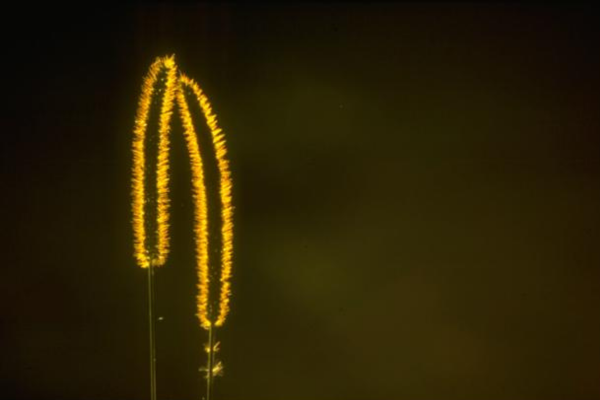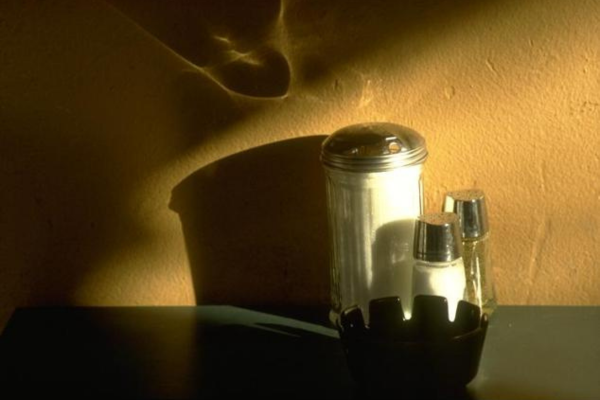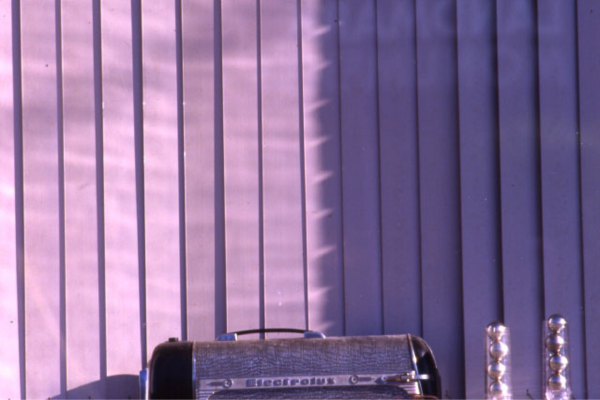Monday
Contemplative Art and Liberation—How it Works Part II
by John McQuade
The great Dharma Master Chögyam Trungpa Rinpoche presented the Buddhadharma and was the progenitor of the Shambhala teachings.
He also was a dharma or contemplative artist in disciplines such as Ikebana, calligraphy, poetry, theatre, photography, “elocution” and so forth. On various occasions he taught the principles and ways of Dharma Art. Some of these teachings are gathered in the book, True Perception.
One of the main points—perhaps the main point—of both the Buddhadharma and Shambhala Dharma ways is liberation: the shift from suffering to ease, self-obsession to compassion, discord to harmony, confusion to Wisdom, setting sun to Great Eastern Sun and so forth.
One might wonder why this great master would bother teaching Dharma Art. Is it an extra or something decisive and helpful as a liberation way? My experience is that these Dharma arts are not only intrinsically liberation ways, but they can act as a catalyst for the Buddhadharma and Shambhala liberation ways. Those ways become more effective, expressive and joyful.
Here is an excerpt of text from Chögyam Trungpa’s Shambhala: Sacred Path of the Warrior from chapter V: Synchronizing Mind and Body. This teaching is presented in three interrelated phases: teachings on synchronization, teachings on direct or true perception and teachings on fearlessness, human dignity and Great Easter Sun vision. This contemplation will focus on the second phase: direct perception.
First there is a little presentation on synchronization. Here the reference is to the synchronization of mind, body and world in contrast to what we often experience as a scattered, awkward and somewhat dysfunctional way with ourselves and the world.
One of the main points is that this capacity for synchronization is not an external imposition but rather a reconnection with our birthright human synchronization: “Synchronizing mind and body is not a concept or a random technique someone thought up for self-improvement. Rather, it is a basic principle of how to be a human being and how to use your sense perceptions, your mind and body together.”
So one of the decisive issues is how to “use your sense perceptions” as a way of synchronization. This is the second phase of the teachings.

“Synchronizing mind and body is also connected with how we synchronize or connect with this world altogether. This has two stages which we call Looking and Seeing…it is somewhat easier to explain the process…in terms of visual perception.”
Then: “Looking is your first projection and if you have doubt…you feel shaky or anxious because you do not trust your vision…but the point is to look properly. See the colors: white, black, blue, yellow, red, green, purple. Look. You cannot not look. There is no other world. This is your world: it is your feast. You inherited these eyeballs; you inherited this world of color. Look at the greatness of the whole thing. Look! Don’t hesitate—Look! Open your eyes. Don’t blink, and look, look—look further.”
So this is how you do it. But how do you do it? This teaching is more of an experience description, a “pointing out” and an invocation. With all due respect it does not provide a practice/experience way.
Miksang contemplative photography provides a practice/experience way (there could be other practice ways as well).
Miksang is a Tibetan word that translates as “Good Eye.” In Shambhala terms it is the “eye or visual” way of Basic Goodness.
Miksang is a Tibetan word that translates as “Good Eye.” In Shambhala terms it is the “eye or visual” way of Basic Goodness.
Miksang asked the question: What is the visual? One could respond that the visual is what we see: what the visual sense registers/presents. What we see is everything that we see. Everything is a big and endless exploration. This is not workable as pedagogy. So we asked does the visual have features, components, elements and so forth. It turns out it does. Everything we see involves color, light, surface (our vision stops at a surface), space and we always see something in particular.

So the first phase—the Looking phase—of the Nalanda Miksang pedagogy and perception/expression training is to work through each of these visual elements. So the first assignment is to explore color as color. Then we explore light and the others.
Now we are embodying, expressing and manifesting Chögyam Trungpa’s teachings. We actually engage Looking as a real register experience. This is a liberation practice and experience. You are there with your direct visual experience. This is a first synchronization contact.
Then there is Seeing.“ You might see something which is the second stage—the more you look the more inquisitive you are, the more you are bound to see—and appreciate the world around you. It is a fantastic new discovery of the world. You would like to explore the entire universe.”
So, after establishing the first visual direct perception contact, the stage of Seeing involves the “inquisitive” “appreciation” and “exploration.” This is where Insight and Liberation ensue.
In Nalanda Miksang there are many contemplative exploration and insight ways. This is the main orientation of Nalanda Miksang. In general, they are presented through another Chögyam Trungpa teaching: Fields of Perception.
Here I am presenting some more basic and fundamental Nalanda Miksang Insight teachings. These are more rooted in the Looking phase of direct perception. The first assignment is “color as color.” Not a colorful thing like a balloon, a flower, or a fire engine. Our slogan is, “fire engine red not a red fire engine.”

This has profound experience, implication and insight registrations. One of the features of this engagement is to discern the difference between the orientation to the “thing world” and the actual experienced appearance/phenomenal world. We actually first see a “fire engine” in terms of its colors, shapes, volumes and so forth. Notions like tires are conceptual additions. For example we cannot see the other side of the fire engine even though we “know it is there.”
This is the thing orientation. This is not exactly mistaken—it is part of our conceptual/pragmatic way of operating in our world. But it is not direct perception. Direct perception is the appearance/phenomenal manifestation. This is what we experience.
More so there is a co-presence of what we experience and the phenomenal manifestation. This is our direct perception contact. As Chögyam Trungpa says:
“There is no other world. This is your world; it is your feast.”
So the features of the appearance phenomenal world are the manifest ways of your experience. The way of appearances is fresh, fluid and free flowing. This means your experience is fresh, fluid and free flowing. This is a first step of contemplative liberation, it is never the “same old, same old.”
This Seeing/insight can run deeper and much deeper. Chögyam Trungpa notes the aspect of “appreciation.” Appreciation means to discern true value. To give a material example: if one wanted to know the value of a piece of jewelry one could go to an appraiser.
Here we are involved with the Wish Fulfilling Jewel: your life. These contemplative art practices are “appreciation ways.” Your life becomes more meaningful in the way that it is always already meaningful. This is everyday liberation.
Then there is the deep liberation insight into the way of reality manifestation. In terms of the Buddha Dharma one would contemplate how the contemplative break from the “thing orientation” to the phenomenal manifestation resonates with a basic teaching such as the Heart Sutra Emptiness/Form.
Here we will stay with this Chögyam Trungpa text. In the Looking section of the text he presents some Insight teachings:
“You inherited this; you inherited these eyeballs: you inherited this world of color.”
Here there is a pointing to the link of the primordial with the phenomenal. We are born with the capacity of vision that opens the visual world. It is a birthright miracle. It does not depend on any conditioned circumstance—other than being born as a human. It does not depend on your gender, your age, your ethnicity, whether you are rich or poor and so forth.
So there is a deep connection between this primordial miracle birthright and each every day, every moment perception way of being in the world. This realized connection is deep liberation.
We have to be kind and reasonable here. This is not a judgment. Our lives are demanding and the “thing world” is a big part of our ongoing orientation. However, it is not our whole world or even our basic experience world. So it is a matter of shifting our allegiance more and more as much as we can and mixing this into the appreciation of our everyday life. This is contemplative liberation. And a special feature of contemplative liberation is that it can be easily integrated with our everyday lives. Indeed, our everyday lives become the way of contemplative liberation.
In the third phase of this text Chögyam Trungpa links this direct perception engagement to the way of everyday warriorship:
“You can see on the spot with wakefulness. Your eyes begin to open…you can see the world is colorful, fresh and free…fantastic…in that way, synchronization of mind and body is also connected with fearlessness…here fearlessness means being able to respond to accurately to the phenomenal world…you begin to realize that you have a perfect right to be in the universe…you have looked and you have seen…this discovery is the first glimpse of what is called the Great Eastern Sun…the dawning or awakening of human dignity—the rising of human warriorship.”
Entries filed under Arts and Poetry
Tea: A Mirror of the Soul – HIGHLIGHT
From the column Shambhala at the Movies, by Angela Pressburger This week’s movie is TAN DUN: TEA – A MIRROR OF THE SOUL (English with Chinese, French, German, and Spanish subtitles. 2002, Japan/Germany, 120 min). Chinese composer Tan Dun has won many awards for his scores to the ... continuePosted January 7, 2010 by
Confessions of a Householder – HIGHLIGHT
By Acharya Michael Greenleaf Let’s face it. A house is not Zen. I never really wanted a house. It was my wife’s idea. My ideal scenario was to live in a van. There are many advantages to a van. Maybe it’s a guy thing. For one, who ever heard ... continuePosted January 6, 2010 by michaelgreenleaf
Kitchen Shrine at Dorje Dzong
Phyllis Segura offers recommendations for a kitchen shrine, inspired by our recent interview with Sangyum Wendy Friedman and Kusung Dapon Noel McLellan on Shambhala Households. Click on images to enlarge: #gallery-1 { margin: auto; } #gallery-1 .gallery-item { float: left; margin-top: 10px; text-align: center; width: 33%; } #gallery-1 img { border: 2px solid #cfcfcf; } #gallery-1 .gallery-caption { margin-left: 0; } /* ... continuePosted January 2, 2010 by Phyllis Segura
Dancing Life – HIGHLIGHT
A Playful Encounter of Maitri and Dance By Alexa Gould-Kavet This October, the large shrine room floor was caressed, stomped, delicately slithered and tiptoed across by thirty sets of feet. These feet, each day, were swathed in red, green, yellow, blue and white. Our feet come to mind ... continuePosted December 7, 2009 by
Shambhala Sun Auction Open through December 13
The Shambhala Sun Foundation’s 3rd Annual Auction is now underway and runs through December 13. We welcome your support through visits and bids. Browse the auction here. To register, click here. You’ll find calligraphies by Chogyam Trungpa and Thich Nhat Hanh, signed books by Pema Chodron, retreat ... continuePosted December 1, 2009 by mollydeshong
Expressing Love of Food in Jewellery – HIGHLIGHT
Berkeley Brown reflects on the jewellery she creates on the occasion of her first solo exhibition in Halifax, titled “Whisked Away.” The value of food in our society is fascinating; I am intrigued by the way our relationship to it allows food to transcend its ... continuePosted November 28, 2009 by
Sukhi Barber’s exhibit in London
Do you want to see the buddha nature manifest?!?…. Then, go check out this exhibit in London starting December 3. Exhibit at Albemarle Gallery December 3rd to January 16th 49 Albemarle Street London W1S 4JR Tel : 020 7499 1616 http://www.albemarlegallery.com/ Sukhi Barber was born in Hertfordshire, England. From an early age she ... continuePosted November 26, 2009 by
Introducing “Shambhala at the Movies” – HIGHLIGHT
A new column by Angela Pressburger “I think that a film should have a good story, a clear story, and it should have, if possible, something which is probably the most difficult thing – it should have a little bit of magic….Magic being untouchable ... continuePosted November 24, 2009 by
“As many languages as people”, a photographic journey
Starting the 8th of November, is a joint exhibition in the Benedictushof Centre for Spiritual Pathways in Holzkirchen (near Würzburg, Germany) of photographer Zsolt Suto and sulptor Max Schmelcher. The background story behind this expo: You might remember that the pictures were taken in 2oo7 while traveling in the footsteps ... continuePosted November 8, 2009 by
“Art” is a Process, “Arts” is a Form – HIGHLIGHT
By Steven Saitzyk Within the Shambhala global mandala there are many titles, programs, and projects that carry the moniker “Shambhala,” and they are increasing all the time. It can be confusing because they can sound alike, especially Shambhala Art and Shambhala Arts, or Shambhala Art ... continuePosted October 27, 2009 by Steven Saitzyk
Rinpoche’s Gauntlet – HIGHLIGHT
By Steven Saitzyk Black and white photos courtesy of Andrea Roth In 1979, or maybe 1980, I met with a group of artists in Los Angeles about an installation. The person creating the installation was my teacher Chogyam Trungpa Rinpoche, though in the art world he ... continuePosted September 4, 2009 by Steven Saitzyk
The Power of the Feminine – HIGHLIGHT
A Poem By Joan Whitacre To the soft power of the feminine gently stroking all closed hearts to yield, to care for water’s sweet taste for breezes’ balmy caress for grasses’ willowy waving for fire’s radiant glowing for all sentient beings’ cooing, laughing, peeping, crying. To the tough power of the feminine firmly cutting ... continuePosted August 23, 2009 by
Medicine Buddha Aspirations – HIGHLIGHT
By Timothy Walker Just before and during the closing feast for Gyetrul Jigme Rinpoche’s Medicine Buddha Retreat, I wrote the following poem of praise to the Medicine Buddha and read it aloud to the assembly. I share it here in this spirit of healing whatever needs ... continuePosted July 22, 2009 by
Summer’s Full Moon Song – HIGHLIGHT
A mahamudra song by T.W., a Ripa Ladrang sangha member Oh, oh, oh the moon cried So full and heavy she hung low In the late August night sky So bright from crying for her beloved She painted the black night blue And made the crickets sing to a full heaven A song ... continuePosted July 20, 2009 by
Sound the Great Trumpet of Dharma Art! – HIGHLIGHT
Where were you on Shambhala Art Day? Send us your pictures, stories, videos, drawings… And let’s make all Dharma Arts shine, sparkle and illuminate the Shambhala Times! continuePosted June 6, 2009 by Jessica Sarapoff
![]() RSS feed for the Arts and Poetry category
RSS feed for the Arts and Poetry category
View all posts from authors in Arts and Poetry: Jillian_Johnson





























